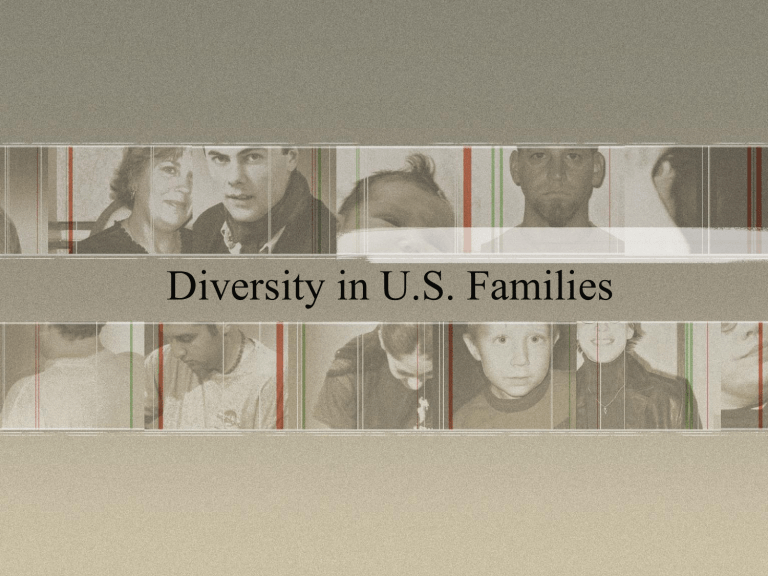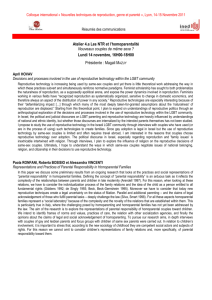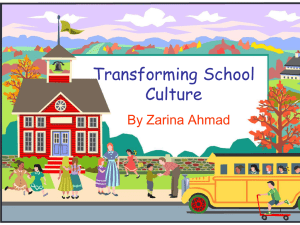Diversity in U.S. Families - Grayslake North High School

Diversity in U.S. Families
Write down your definition of the stereotypical family.
• Working dad
• Stay-at-home mom
• 2 or 3 children
Only 10% of all households are in this family form.
The
American Family
• There is no such thing as the American
Family, family life varies widely throughout the U.S.
• Just as above, there is no such thing as the African American Family or Asian
American Family.
– The primary distinction is between social class.
Upper-class African American Families
• Upper-class African American families are concerned with preserving their privilege and wealth.
• Since marriage is viewed as a merger of family lines, upper-class African-American families are especially anxious about the family background of their children’s prospective mates.
• Children marry later than children of other classes.
Middle-class African American Families
• Focus on achievement and respectability
– Pushing children to go to college, get good jobs, and marry educated, respectable, and hardworking people like themselves.
African-American families in Poverty
• Face all the problems that are generally associated with poverty.
– With few skills and not enough good jobs, many of the men have a difficult time fulfilling the cultural roles of husbands and fathers.
– African-American women, on the other hand, are faced with a marriage squeeze :
• an imbalance in the sex ratio created, in this instance, by not enough eligible African Americans men for the numbers of unmarried African American women.
– As a result, African American families are the least likely to be headed by a married couple, and African American women are more likely than other racial-ethnic groups to marry men who are less educated then themselves.
Social Class Factors: Latino
Families
• The proportion of Latino families headed by married couples falls between that of whites and African-Americans
• Proportions differ by country of origin.
– Latino families from Cuba are more likely to be headed by a married couple than families from Puerto Rico
• Major difference between Latino families and other racial-ethnic families is culture
– Spanish language
– Roman Catholic religion
– Strong family orientation with disapproval of divorce
Machismo
• An emphasis on male strength and dominance
• The husband-father plays a stronger role than in either white or African American families
• Machismo apparently decreases with each generation in the U.S.
Asian American Families
• Almost identical to that of white families
• Because Asian Americans come form twenty different countries, their family lives vary, reflecting their many cultures.
• As with Latino families, the more recent their immigration, the closer families reflects country of origin.
• Although adopted the nuclear family, also retain Confucian values that provide a distinct framework for family life:
– Including humanism
– Collectivity
– Self –discipline
– Respect for the elderly
– Obligation
• Parenting: more permissive than whites in child rearing and more likely to use shame and guilt than physical punishment to control children’s behavior.
Native American Families
• Most significant issue is whether to adhere to traditional values
– Speaking Native languages
– Emphasizing distinctive Native American values and beliefs
– To assimilate into the dominant white culture
• Structure closely resemble Latino families
• Parenting: permissive with children and avoid physical punishment. Elders play a much more active role in children.
Figure 16.4 Family Structure: The Percentage of U.S. Households Headed by Men, Women, and Married Couples
Source: By the author. Based on Statistical Abstract 2000: Table 44; 2002: Tables 37, 38, 40.
One Parent Families
• Have become a matter of general concern in U.S.
• Percent of children living with both parents dropping from 85% in 1970 to 69% today.
• Two primary reasons:
– High divorce rate
– Increase in births to unmarried women
• Most head by women, most poor
• Children are more likely to:
– Drop out of school
– Get arrested
– Have emotional problems
– Get divorced
– If female, more likely to have children as unmarried teens
Figure 16.5 The Decline of Two-Parent Families
Source: By the author. Based on Statistical Abstract 1995: Table 79; 2002; Table 54. *author’s estimate
Gay and Lesbian Families
• In 2000, the state of Vermont became the first state to legalize
“gay unions”, joining a number of European countries that have made same-sex marriages legal.
• Gay and lesbian families in the U.S. are highly urban, with about half of them concentrated in just 20 cities.
– The cities with the greatest concentration of gay families are San
Francisco, Los Angeles, Atlanta, New York City, and Washington D.C.
– About one fifth of gay and lesbian couples were previously married to heterosexuals.
– 22% of lesbian couples and 5% of gay couples have children.
• Same-sex couples face many of the same problems as heterosexual couples:
– Housework
– Money
– Careers
– Problems with relatives
• Are more likely to break up, however, and one argument for legalizing gay marriages is that it would lead to longer-lasting relationships.
http://thesocietypages.org/socimages/2012/03/14/updated-map-of-legal-statusof-same-sex-marriage/
Families Living in Poverty
• http://www.cbsnews.com/video/watch/?i
d=7389750n
• http://www.cbsnews.com/video/watch/?i
d=7358670n











